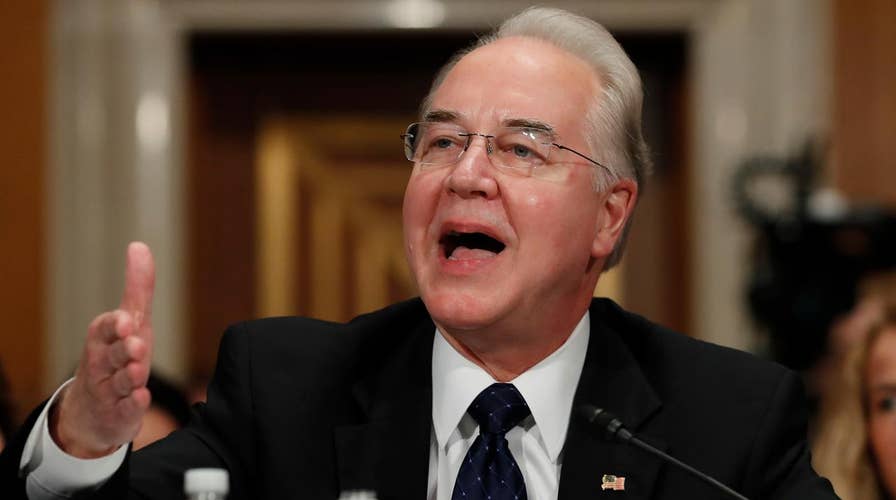How would Tom Price change health care in America?
Dr. Nicole Saphier reacts to the HHS secretary nominee's Senate hearing
Too often, the practice of medicine in the United States is focused on treatment. Doctors are taught to battle disease and treat chronic illness to the bitter end, and we have amazing technologies and treatments that have been proven to save lives — but our costs and health outcomes don’t seem to match what we pour into the system.
But what if we doctors changed how we think about battling disease? What if we focused on prevention, rather than treatment? What if our goal were to put ourselves out of business?
That’s where more of our health care tax dollars should be directed and Dr. Tom Price, the Georgia congressman who was sworn in on Friday agrees.
Price, an orthopedic surgeon, understands the relationships doctors and patients must develop. He’s experienced the frustrations of the current American health care system, and he knows patients are no longer the center of the health care debate.
He has fought on behalf of patients with insurers, taken care of those without insurance and seen firsthand the devastation preventable disease can have on patients and their families.
Under our health care system, government organizations such as the U.S. Preventive Services Task Force (USPSTF) can set policy and greatly influence how physicians practice. Their recommendations directly affect reimbursement and help determine what tests and procedures the Centers for Medicare and Medicaid Services (CMS) will cover. Price has been outspoken against USPSTF’s recommendations throughout his career — particularly its latest recommendations for breast and prostate cancer screening.
Though screening for breast cancers clearly lowers risk for death, USPSTF’s recent recommendations make screenings optional for women under 50 and on an every-other-year basis for those between 50 and 74. These changed recommendations will alter the way physicians approach screening, and time will tell if they have long-term effects on breast cancer survival rates. Price has criticized the USPSTF for not having enough expert specialists — particularly in the areas where they are making their more controversial recommendations.
Americans spend far more than any other country on medicine and treatment, yet we’re No. 42 in life expectancy and No. 56 in infant mortality. That’s because Americans generally don’t feel that health is an individual responsibility or that behavior modification is a way to prevent disease.
Fortunately, a large body of data supports the use of screening tests for chronic diseases, and we have reliable tests for prostate, lung, colon and breast cancers — just to name a few. But these tests are not without debate within the medical community. Some say widespread, population-based screening leads to more unnecessary tests and procedures, putting patients at undue risk. Others say doctors use screening tests to generate more patients and procedures.
Nothing could be further from the truth.
We must change the way doctors and health care systems think in the U.S. today. The Affordable Care Act — ObamaCare — was supposed to give patients access to more preventive care. But, in reality, all it did was provide emergency access to those who had urgent medical needs. Lack of accessibility, high costs and lack of timely availability of physicians who participated in the ACA exchanges limited patients from receiving preventive care.
We must reward physicians for preventing disease, and we must hold patients individually accountable for behaviors that put them at higher risk for certain diseases. If we are to ever improve outcomes, increase life expectancy and improve infant mortality rates, it will be due to changing health and wellness behaviors, not from spending trillions of dollars on treating chronic preventable diseases.
Prevention also has long-term economic effects that reach far beyond direct medical costs. It can reduce absence from work — absenteeism resulted in nearly $85 billion in productivity losses last year alone — and improve worker and corporate productivity.
Good health affects us all. It affects our quality of life and the economy, as well. But prevention starts with you. It entails:
1. Taking stock of your own health risks.
Understand your family history and how it affects your risk for disease. Know your numbers — BMI (body mass index), fasting blood sugar, blood pressure and cholesterol. If you know your individual risk, you can make changes to affect it.
2. Making changes to modify risk.
Understand that exercise and diet are critical to reducing risk. Know that smoking is the No. 1 cause of preventable death in the U.S. today. Obtaining an ideal body weight or BMI reduces your risk for diabetes, high blood pressure and heart disease (the No. 1 killer in the U.S. today). We must address key indicators of health outcomes — smoking, physical activity levels and diet — to improve our health and reduce costs.
3. Getting regular screenings
Work with your health care provider to make sure you know when and how to screen for cancers and other diseases. If you test positive, get multiple opinions before you do anything, so you can make the decision that’s right for you.
4. Engaging with a health care provider/partner
Developing a long-term relationship with a physician can make a big difference in your health status and outcomes.
Tom Price, as HHS secretary, will help us begin an important transition in American health care: focusing on the patient — not the politics — and making sure we prevent disease before too many lives are lost. Prevention must be our goal.
I challenge all my colleagues who treat terrible diseases … Let’s put ourselves out of business. Let’s work to make America healthier than ever!

